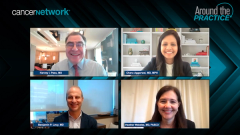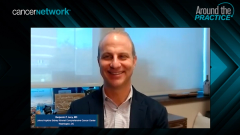
Factors in Selecting Therapy for Non-Small Cell Lung Cancer
Expert panelists look at all factors that inform treatment selection when managing a patient diagnosed with non–small cell lung cancer.
Episodes in this series

Transcript:
Charu Aggarwal, MD, MPH: As we talk about biomarker testing, in addition to disease stage, and of course histology, are there other patient factors or treatment factors that you think about when you’re thinking about biomarker testing? I’ll start with you again, Heather.
Heather Wakelee, MD, FASCO: As much as we all know that any patient’s tumor can harbor a driver mutation, there certainly are probabilities that are related to the patient, their history, their smoking history, their ethnic background. At least, for this idea about whether to do any of that testing before you make your decision about the perioperative treatment tree, we do take that into account. So, if a patient has a very heavy smoking history, the probability that they’re going to have an EGFR or ALK [gene mutation] is relatively low, and the probability they might have actionable PD-L1 is higher. We’re thinking a little differently, but in either case, there’s still a test that might help you, and so that’s where this idea comes in of knowing PD-L1 and looking for EGFR and ALK. There are still so many other drivers that you’re missing, but we don’t really know what to do in that setting, nor do we really know what to do in the setting of ALK or EGFR in the preoperative setting. But I think it makes us less inclined toward a neoadjuvant immune therapy approach in that setting. That’s where I think it’s important.
I realize my practice and whom I treat is a little different than in many other parts of the world because half of my practice are patients whose tumors have EGFR or other drivers. We’re just very mindful of that. I worry if we get into reflex testing that’s just the IHC [immunohistochemistry] and the PD-L1, then we miss the patients who have high PD-L1 and EGFR, or high PD-L1 and a tumor with ALK and ROS. Those are the ones that really concern me because there we might end up on the wrong treatment path because we don’t have the full information. That’s part of why we do all of that. Hopefully, that answered the question.
Charu Aggarwal, MD, MPH: Are you more likely to look in your population if you get negative plasma or a negative initial round of tissue? Are you more likely to go back in for another biopsy based on maybe a nonsmoking patient?
Heather Wakelee, MD, FASCO: We do. I think if they’ve had both a good liquid biopsy and a good tumor specimen tested, we acknowledge that there are patients who have all the phenotypical expectations of having a driver mutation who just don’t have one that we know about. Obviously, there’s something, but not one that we know to look for. I don’t give up with 1 test. I’ve certainly had more than 1 patient come to see me for whom we were able to find a driver mutation that changed their treatment pattern. Certainly, some are found on liquid biopsy that we didn’t find on tissue, but it goes both ways. You and I both have published things saying that.
Charu Aggarwal, MD, MPH: Yes, definitely. Ben, anything to add?
Benjamin P. Levy, MD: I want to make the point that Heather made about clinical phenotype. That really shouldn’t drive decision-making on testing, and so they need to be testing everyone, smokers, never smokers. Even our squamous cell, there’s some suggestion that we should be testing patients who are squamous cell, at least light smokers or never smokers who have squamous cell. There are actionable mutations that we can unearth. I think for patients with advanced stage disease, we try to do both again, plasma and tissue. In a plasma positive, we don’t wait for the tissue. I think a good point that was made is that for the patients who are more likely to harbor these alterations, these never smokers, if both the plasma and tissue are negative, I don’t give up. It’s important to recognize, and I think we all do, tissue heterogeneity and where that needle is when the tissue is procured may not identify the alteration. There may be an opportunity to rebiopsy these patients and send it to a different panel. I also have been fooled by a negative liquid and tissue where we rebiopsied, and then found an alteration by sending it off to another place, an outside place rather than our own. Just leave no gene behind, especially for those never smokers. Work hard to try to find them.
Heather Wakelee, MD, FASCO: I’d add too, in that vein, I have a patient for whom we finally found her ROS translocation. She’d been living for 10 years with metastatic disease, which when we found out about the ROS, it now made sense. There are a lot of patients who do live a longer time. She’s never had targeted therapy. And when we relooked at the testing that she’d had done years and years ago, there was a faint signal, but it wasn’t really identified at the time. I think one of the lessons of that is technology evolves. For patients who were diagnosed in the past where you still don’t know, that retesting makes sense. I think Ben, you were talking more about in real time now, but going back and looking for these patients can certainly yield important information sometimes too.
Charu Aggarwal, MD, MPH: Absolutely. Harvey, I would like to ask you, you said most of the early stage patients are discussed in a multidisciplinary setting. How do you ensure that communication is occurring between all of the members? What do you suggest as the best practice?
Harvey I. Pass, MD: We have clinic together. In other words, the way we set it up when I came to NYU [New York University Langone Health] was that the surgeons were going to be at the cancer center. The busy surgeons were at the cancer center, along with the pulmonologist, on the same floor so that there could be instant referrals, instant talking, not this next day sort of stuff. Plus, that gets reinforced then at the multidisciplinary conference, where all the pulmonologists are there who do interventional, as well as the surgeons, as well as all the medical oncologists, the NPs [nurse practitioners]. That’s the way it should be. That way, if it turns out that we have to do a rebiopsy, because we have very talented interventionalists who know how to do robotic bronchoscopy, as well as all sorts of other localization techniques, we have a pretty good track record of being able to get the data for the sequences that need to be looked at. It depends upon a lot of cooperation, but it works very well at our place, in my opinion, especially when you’re trying to develop and get people to go on protocol.
Charu Aggarwal, MD, MPH: Absolutely. You have been one of the leaders to establish early interventions in patients with early stage lung cancer. I think your model of multidisciplinary collaboration is something to be followed. I think multidisciplinary clinics are exceptionally able to have real-time collaboration, but definitely, communication is key.
Transcript edited for clarity.
Newsletter
Stay up to date on recent advances in the multidisciplinary approach to cancer.























































































